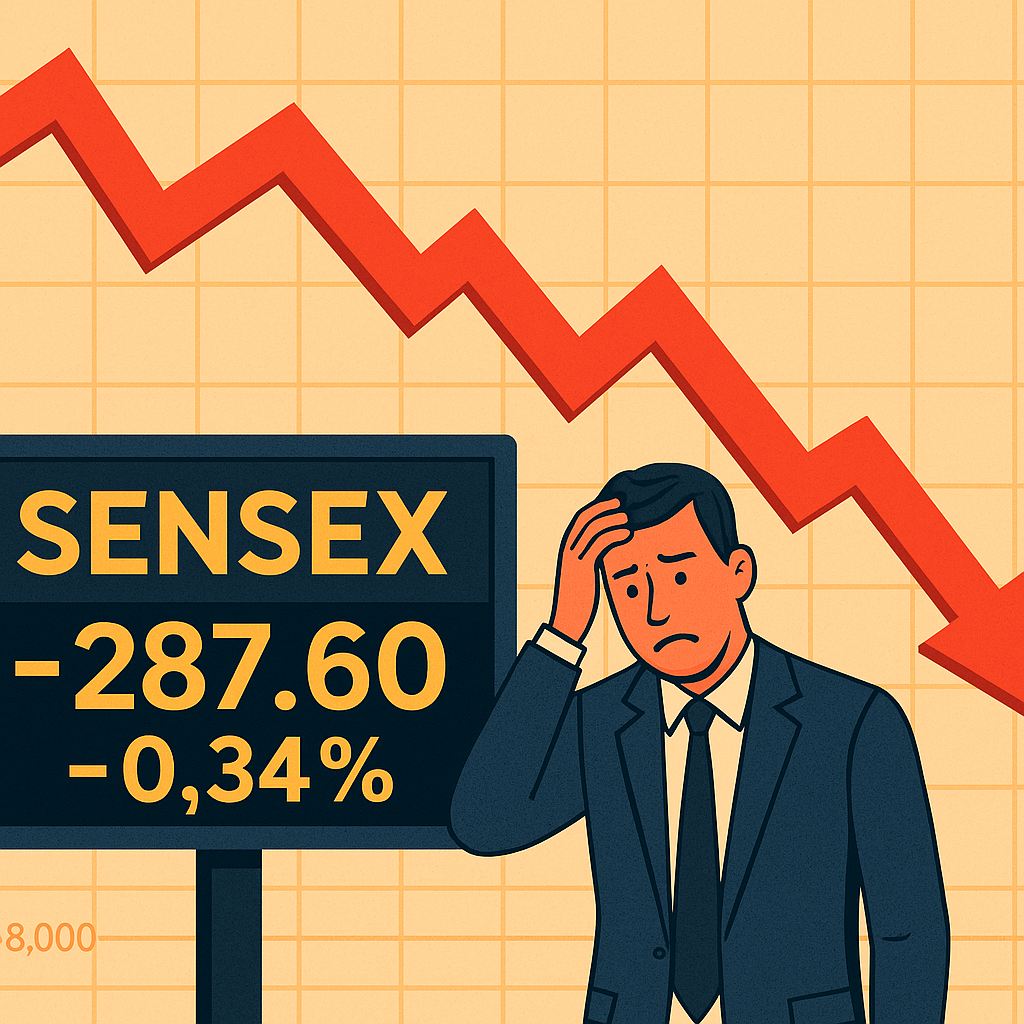In a sharp reversal from early gains, Indian equity markets witnessed a downward swing on Wednesday, as the Sensex ends 287 points lower, led by heavy selling in blue-chip stocks like HDFC Bank, Larsen & Toubro, and Reliance Industries. The benchmark indices faced strong resistance despite initial momentum, impacted by global cues, foreign institutional investor (FII) outflows, and anxiety ahead of the looming U.S. tariff deadline.
At the end of the trading session, the BSE Sensex closed at 83,409.69, down by 287.60 points or 0.34%. During intra-day trade, the index dropped as much as 546.52 points, indicating high volatility. Similarly, the NSE Nifty 50 declined 88.40 points or 0.35%, settling at 25,453.40. The day’s movement highlights a broader market cautiousness, especially as the Sensex ends 287 points lower despite robust domestic indicators.
Key Laggards Drag the Market Down
A host of heavyweight stocks were responsible for dragging indices into the red. The Sensex ends 287 points lower primarily due to weak performance by:
- HDFC Bank
- Bajaj Finance
- Bajaj Finserv
- Larsen & Toubro (L&T)
- Bharat Electronics
- Kotak Mahindra Bank
These stocks suffered significant losses following a wave of selling pressure from both domestic and foreign investors.
In contrast, Tata Steel, Asian Paints, UltraTech Cement, and Trent emerged as the session’s top gainers, providing some relief but not enough to counter the bearish tide.
Foreign Institutional Outflows Add to Bearish Sentiment
The sharp decline was also attributed to heavy foreign fund withdrawals. According to exchange data, FIIs pulled out Rs 1,970.14 crore from Indian equities on Tuesday alone. This sell-off is in line with global investor behavior, as risk-off sentiments rise amid increasing geopolitical tensions and policy uncertainties.
As a result, the Sensex ends 287 points lower, echoing investor unease over sustained capital flight from the market.
Global Markets Offer Mixed Signals
International stock markets did little to support Indian equities. In Asia, South Korea’s Kospi, Japan’s Nikkei 225, and China’s SSE Composite all ended in the red. However, Hong Kong’s Hang Seng bucked the trend, closing marginally higher.
European markets, by contrast, were trading positively during India’s mid-session, while U.S. indices posted mixed results in the previous session. These diverging cues compounded the uncertainty and contributed to the domestic market volatility that saw the Sensex ends 287 points lower.
Upcoming US Tariff Deadline Looms Large
One of the biggest factors rattling global and domestic markets alike is the upcoming U.S. tariff deadline, which could trigger fresh trade tensions. Investors remain wary, preferring a “wait-and-watch” approach.
Vinod Nair, Head of Research at Geojit Financial Services, noted, “Mixed global cues, particularly ahead of the impending tariff deadline, are driving investor caution. Market attention is gradually shifting to crucial Q1 earnings, which have high expectations.”
As investors price in uncertainty, the Sensex ends 287 points lower, symbolizing the cautious trading mood.
Domestic Macroeconomic Indicators Show Strength
Interestingly, the market decline contrasts with encouraging domestic indicators. India’s manufacturing sector witnessed a 14-month high in June, with the HSBC India Manufacturing Purchasing Managers’ Index (PMI) climbing to 58.4, up from 57.6 in May. The surge reflects strong demand, improved output, and a record rise in employment.
Additionally, the Gross GST collection in June rose 6.2% YoY to Rs 1.84 lakh crore, albeit slipping below the Rs 2 lakh crore mark achieved in April and May.
Despite such resilience in the macroeconomic landscape, market nervousness ruled the day as the Sensex ends 287 points lower.
Broader Sectoral Trends
While banking and financial stocks bore the brunt of the market downturn, select sectors managed to stay afloat. Cement and steel witnessed positive traction, with UltraTech Cement and Tata Steel posting gains.
The oil and gas sector also showed modest improvement, buoyed by a 0.86% rise in Brent Crude prices, closing at $67.69 a barrel.
Nonetheless, the overall market sentiment stayed muted as the Sensex ends 287 points lower, underlining concerns about near-term volatility.
Previous Session Recap: Temporary Positivity
Just a day prior, on Tuesday, the BSE Sensex had closed at 83,697.29, up by 90.83 points or 0.11%, while the NSE Nifty gained 24.75 points to settle at 25,541.80. This optimism was short-lived, as bearish forces returned in full swing the very next day, ensuring the Sensex ends 287 points lower.
What to Expect Ahead
Looking forward, investor attention is likely to remain on two major fronts:
- Q1 Earnings Season: Scheduled corporate results will reveal how well companies performed amid inflationary pressures and rising interest rates.
- Monetary Policy Outlook: As central banks globally review interest rate strategies, any deviation could impact capital flows.
While macroeconomic indicators remain strong, technical resistance levels and global tensions could lead to more choppy sessions in the days to come.
Market experts suggest that traders remain cautious and avoid aggressive bets until clearer direction emerges.
Conclusion: Volatility Returns as Sensex Ends 287 Points Lower
The Indian equity market is currently at a crossroads. On one hand, robust economic fundamentals like increased GST collections and manufacturing growth offer reassurance. On the other, global uncertainties, FII outflows, and sectoral sell-offs continue to weigh on market sentiment.
As the Sensex ends 287 points lower, it’s evident that investor sentiment is sensitive to external triggers. Traders and investors alike should stay vigilant, rely on diversified portfolios, and track developments around tariffs and earnings closely.
In the short term, defensive sectors and fundamentally strong stocks may offer better risk-adjusted returns amid the volatility.


3 thoughts on “Sensex Ends 287 Points Lower: 3 Key Reasons Behind Market Decline Today”
Comments are closed.